Radiology PPP - December: Professionalism in Radiography Essay
VerifiedAdded on 2023/05/30
|10
|2667
|472
Essay
AI Summary
This essay provides a comprehensive overview of professionalism within the field of radiology, specifically addressing the role of student radiographers and their adherence to ethical and professional standards. It defines professionalism, emphasizing the importance of conduct, competence, and ethical behavior in the healthcare setting. The essay explores the responsibilities of radiographers, including their interactions with patients and the significance of maintaining boundaries. It discusses the significance of Continuing Professional Development (CPD) for radiographers, highlighting various methods for lifelong learning and the transition from student to practitioner. Furthermore, the essay links professionalism to the Health and Care Professions Council (HCPC) standards, emphasizing the importance of providing compassionate and non-discriminatory care while adhering to ethical, legal, and governance frameworks. It also addresses the 6 C's of professional practice (care, compassion, competence, communication, courage, and commitment) and the role of CPD in maintaining these core values. The essay concludes by emphasizing the evolving nature of radiography and the critical role of professionalism in ensuring high-quality patient care.
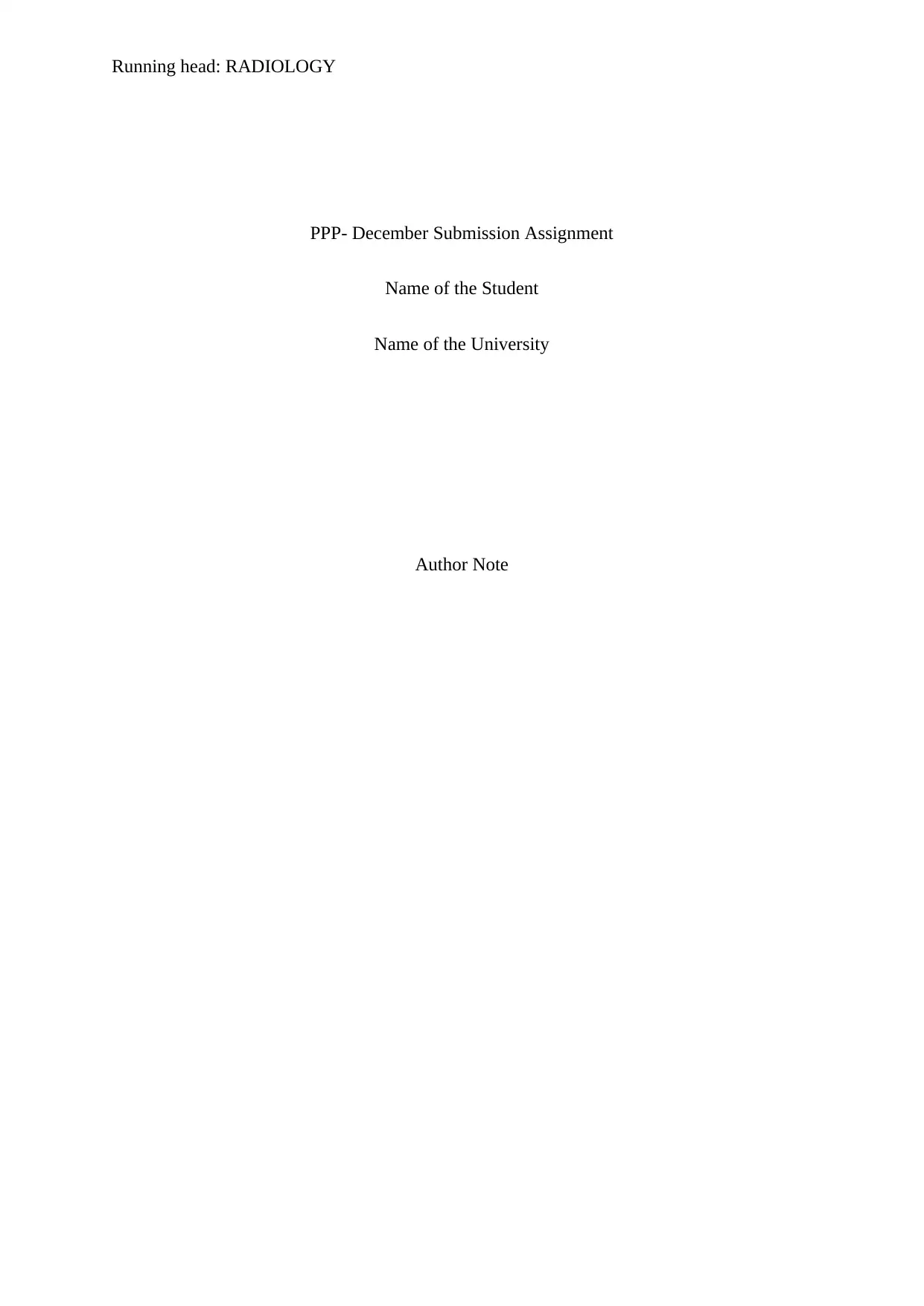
Running head: RADIOLOGY
PPP- December Submission Assignment
Name of the Student
Name of the University
Author Note
PPP- December Submission Assignment
Name of the Student
Name of the University
Author Note
Paraphrase This Document
Need a fresh take? Get an instant paraphrase of this document with our AI Paraphraser
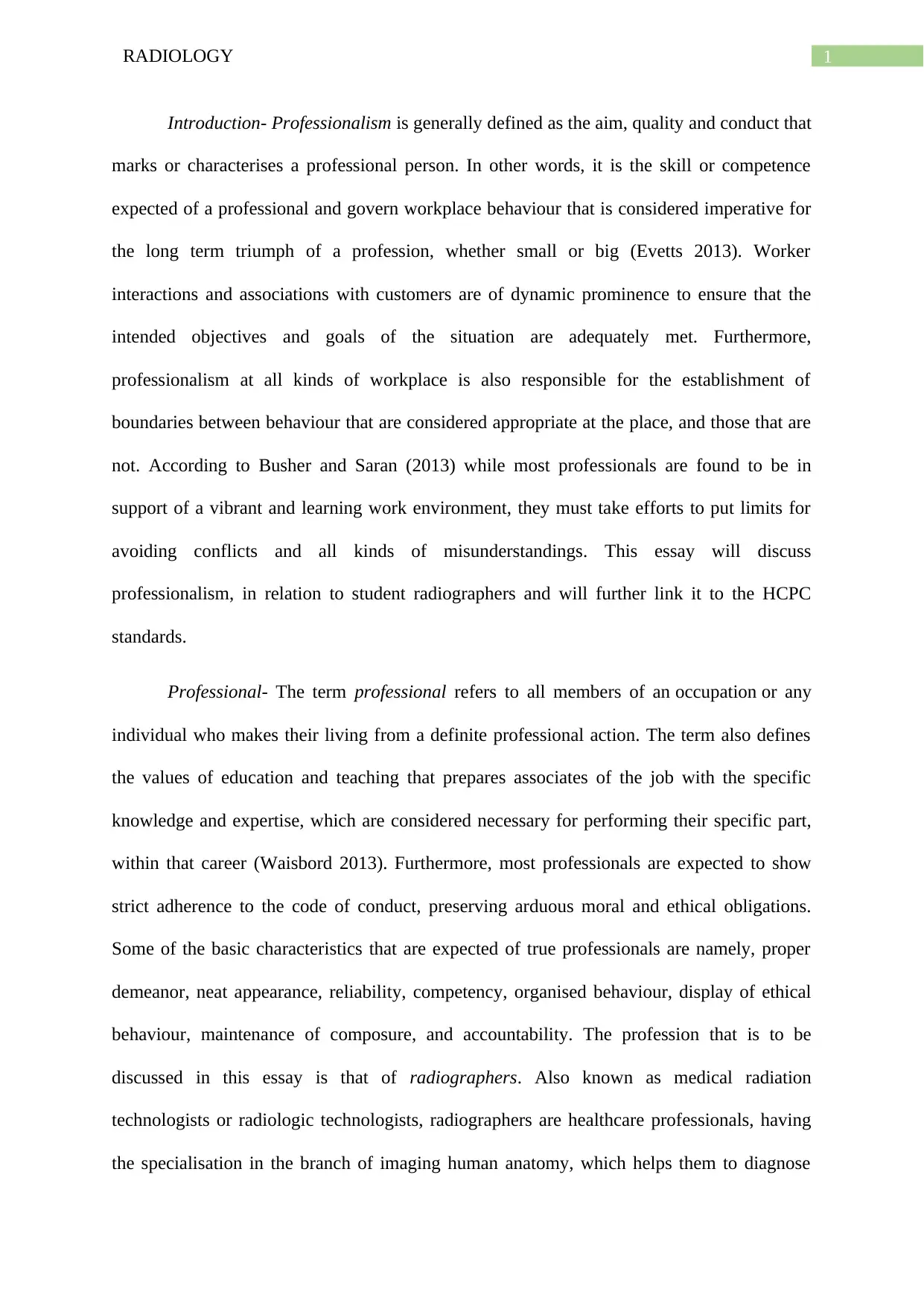
1RADIOLOGY
Introduction- Professionalism is generally defined as the aim, quality and conduct that
marks or characterises a professional person. In other words, it is the skill or competence
expected of a professional and govern workplace behaviour that is considered imperative for
the long term triumph of a profession, whether small or big (Evetts 2013). Worker
interactions and associations with customers are of dynamic prominence to ensure that the
intended objectives and goals of the situation are adequately met. Furthermore,
professionalism at all kinds of workplace is also responsible for the establishment of
boundaries between behaviour that are considered appropriate at the place, and those that are
not. According to Busher and Saran (2013) while most professionals are found to be in
support of a vibrant and learning work environment, they must take efforts to put limits for
avoiding conflicts and all kinds of misunderstandings. This essay will discuss
professionalism, in relation to student radiographers and will further link it to the HCPC
standards.
Professional- The term professional refers to all members of an occupation or any
individual who makes their living from a definite professional action. The term also defines
the values of education and teaching that prepares associates of the job with the specific
knowledge and expertise, which are considered necessary for performing their specific part,
within that career (Waisbord 2013). Furthermore, most professionals are expected to show
strict adherence to the code of conduct, preserving arduous moral and ethical obligations.
Some of the basic characteristics that are expected of true professionals are namely, proper
demeanor, neat appearance, reliability, competency, organised behaviour, display of ethical
behaviour, maintenance of composure, and accountability. The profession that is to be
discussed in this essay is that of radiographers. Also known as medical radiation
technologists or radiologic technologists, radiographers are healthcare professionals, having
the specialisation in the branch of imaging human anatomy, which helps them to diagnose
Introduction- Professionalism is generally defined as the aim, quality and conduct that
marks or characterises a professional person. In other words, it is the skill or competence
expected of a professional and govern workplace behaviour that is considered imperative for
the long term triumph of a profession, whether small or big (Evetts 2013). Worker
interactions and associations with customers are of dynamic prominence to ensure that the
intended objectives and goals of the situation are adequately met. Furthermore,
professionalism at all kinds of workplace is also responsible for the establishment of
boundaries between behaviour that are considered appropriate at the place, and those that are
not. According to Busher and Saran (2013) while most professionals are found to be in
support of a vibrant and learning work environment, they must take efforts to put limits for
avoiding conflicts and all kinds of misunderstandings. This essay will discuss
professionalism, in relation to student radiographers and will further link it to the HCPC
standards.
Professional- The term professional refers to all members of an occupation or any
individual who makes their living from a definite professional action. The term also defines
the values of education and teaching that prepares associates of the job with the specific
knowledge and expertise, which are considered necessary for performing their specific part,
within that career (Waisbord 2013). Furthermore, most professionals are expected to show
strict adherence to the code of conduct, preserving arduous moral and ethical obligations.
Some of the basic characteristics that are expected of true professionals are namely, proper
demeanor, neat appearance, reliability, competency, organised behaviour, display of ethical
behaviour, maintenance of composure, and accountability. The profession that is to be
discussed in this essay is that of radiographers. Also known as medical radiation
technologists or radiologic technologists, radiographers are healthcare professionals, having
the specialisation in the branch of imaging human anatomy, which helps them to diagnose
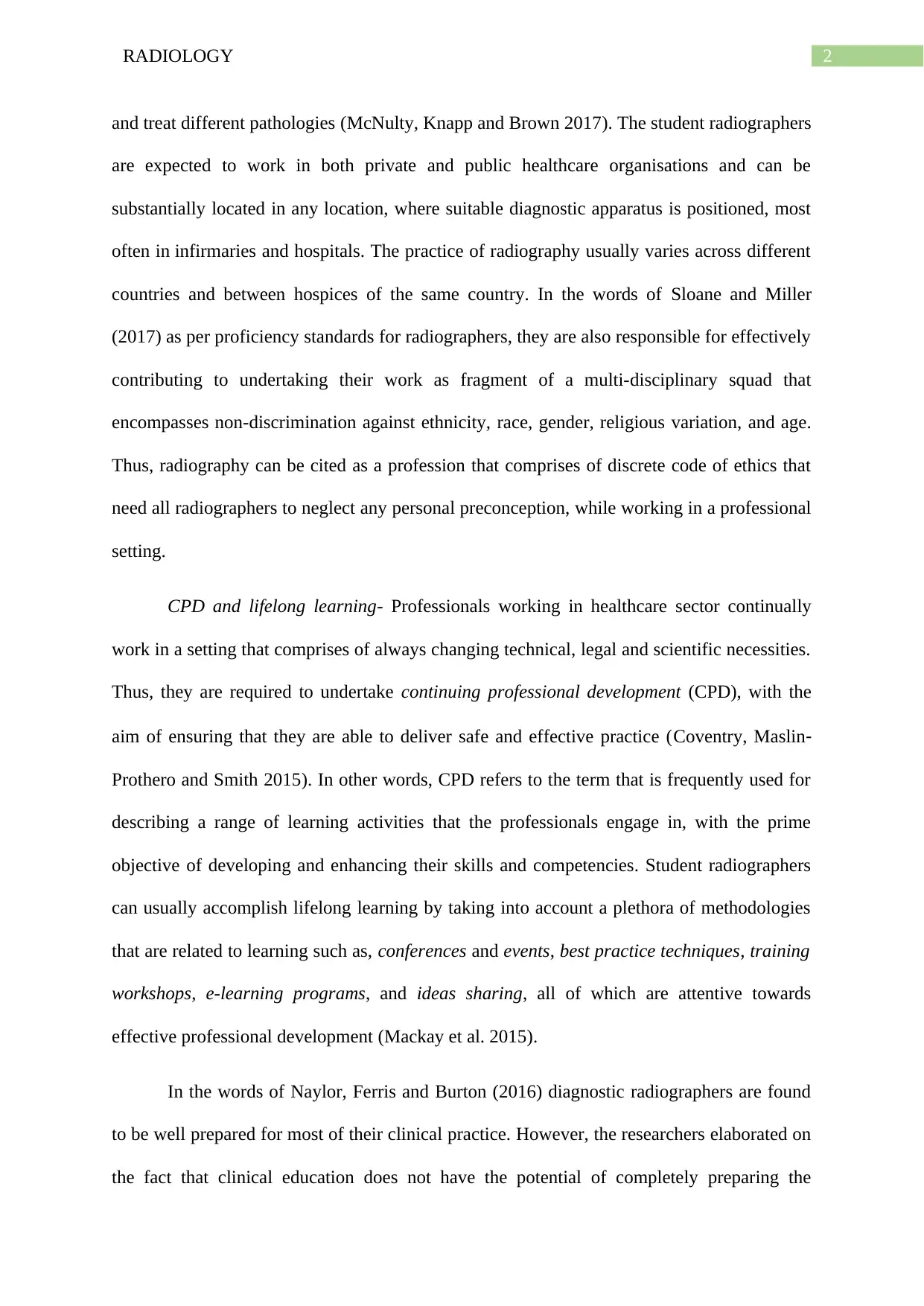
2RADIOLOGY
and treat different pathologies (McNulty, Knapp and Brown 2017). The student radiographers
are expected to work in both private and public healthcare organisations and can be
substantially located in any location, where suitable diagnostic apparatus is positioned, most
often in infirmaries and hospitals. The practice of radiography usually varies across different
countries and between hospices of the same country. In the words of Sloane and Miller
(2017) as per proficiency standards for radiographers, they are also responsible for effectively
contributing to undertaking their work as fragment of a multi-disciplinary squad that
encompasses non-discrimination against ethnicity, race, gender, religious variation, and age.
Thus, radiography can be cited as a profession that comprises of discrete code of ethics that
need all radiographers to neglect any personal preconception, while working in a professional
setting.
CPD and lifelong learning- Professionals working in healthcare sector continually
work in a setting that comprises of always changing technical, legal and scientific necessities.
Thus, they are required to undertake continuing professional development (CPD), with the
aim of ensuring that they are able to deliver safe and effective practice (Coventry, Maslin‐
Prothero and Smith 2015). In other words, CPD refers to the term that is frequently used for
describing a range of learning activities that the professionals engage in, with the prime
objective of developing and enhancing their skills and competencies. Student radiographers
can usually accomplish lifelong learning by taking into account a plethora of methodologies
that are related to learning such as, conferences and events, best practice techniques, training
workshops, e-learning programs, and ideas sharing, all of which are attentive towards
effective professional development (Mackay et al. 2015).
In the words of Naylor, Ferris and Burton (2016) diagnostic radiographers are found
to be well prepared for most of their clinical practice. However, the researchers elaborated on
the fact that clinical education does not have the potential of completely preparing the
and treat different pathologies (McNulty, Knapp and Brown 2017). The student radiographers
are expected to work in both private and public healthcare organisations and can be
substantially located in any location, where suitable diagnostic apparatus is positioned, most
often in infirmaries and hospitals. The practice of radiography usually varies across different
countries and between hospices of the same country. In the words of Sloane and Miller
(2017) as per proficiency standards for radiographers, they are also responsible for effectively
contributing to undertaking their work as fragment of a multi-disciplinary squad that
encompasses non-discrimination against ethnicity, race, gender, religious variation, and age.
Thus, radiography can be cited as a profession that comprises of discrete code of ethics that
need all radiographers to neglect any personal preconception, while working in a professional
setting.
CPD and lifelong learning- Professionals working in healthcare sector continually
work in a setting that comprises of always changing technical, legal and scientific necessities.
Thus, they are required to undertake continuing professional development (CPD), with the
aim of ensuring that they are able to deliver safe and effective practice (Coventry, Maslin‐
Prothero and Smith 2015). In other words, CPD refers to the term that is frequently used for
describing a range of learning activities that the professionals engage in, with the prime
objective of developing and enhancing their skills and competencies. Student radiographers
can usually accomplish lifelong learning by taking into account a plethora of methodologies
that are related to learning such as, conferences and events, best practice techniques, training
workshops, e-learning programs, and ideas sharing, all of which are attentive towards
effective professional development (Mackay et al. 2015).
In the words of Naylor, Ferris and Burton (2016) diagnostic radiographers are found
to be well prepared for most of their clinical practice. However, the researchers elaborated on
the fact that clinical education does not have the potential of completely preparing the
⊘ This is a preview!⊘
Do you want full access?
Subscribe today to unlock all pages.

Trusted by 1+ million students worldwide

3RADIOLOGY
students for the reality of professional practice that they encounter, following their transition
into the real time setting. The transition from student radiographers to practitioners is at a
pivotal time for analytical radiographers as they get on autonomous exercise in a simulating
environment and endure to progress their professional individuality. The working situation
for anew qualified analytical radiographers is changeable with an importance on target driven
work and high pressure, where haste and competence may often struggle with patient care.
The same was confirmed by Stevens and White (2018) who elaborated on the fact that while
most of the student radiographers are confident with their skills that helps them recognise
abnormalities in the profession, 55% of them displayed a lack of assurance on the suitability
of the training provided. Furthermore, despite the interest in continuous learning and CPD, an
estimated one-third of the novice radiographers demonstrated lack of sureness with their
commenting capabilities.
According to the qualitative study conducted by Challen, Laanelaid and Kukkes
(2017) novice radiographers experience moral enculturation into the occupation through a
diversity of experiences in dissimilar educational surroundings to increase an understanding
of professional expectations. Furthermore, it is also expected from the student radiographers
that they would not engage in activities that make them assault, harass, threaten, or intimidate
other individuals. The code of conduct of their university also prevents them from
endangering other’s safety, supplying false information and failing to conform to disciplinary
measures. Owing to the fact that student radiographers lie at the boundary between
technology and patients, they often perceive empathy and communication with patients as
main influences in describing the features of ongoing professionalism (Mc Inerney and Baird
2016). Non-adherence to infection safety and radiation rules are most commonly described
indexes of unprofessionalism, particularly with respect to elderly patients, thus posing threats
all patients. Non-obedience of confidentiality and privacy are another issue that are
students for the reality of professional practice that they encounter, following their transition
into the real time setting. The transition from student radiographers to practitioners is at a
pivotal time for analytical radiographers as they get on autonomous exercise in a simulating
environment and endure to progress their professional individuality. The working situation
for anew qualified analytical radiographers is changeable with an importance on target driven
work and high pressure, where haste and competence may often struggle with patient care.
The same was confirmed by Stevens and White (2018) who elaborated on the fact that while
most of the student radiographers are confident with their skills that helps them recognise
abnormalities in the profession, 55% of them displayed a lack of assurance on the suitability
of the training provided. Furthermore, despite the interest in continuous learning and CPD, an
estimated one-third of the novice radiographers demonstrated lack of sureness with their
commenting capabilities.
According to the qualitative study conducted by Challen, Laanelaid and Kukkes
(2017) novice radiographers experience moral enculturation into the occupation through a
diversity of experiences in dissimilar educational surroundings to increase an understanding
of professional expectations. Furthermore, it is also expected from the student radiographers
that they would not engage in activities that make them assault, harass, threaten, or intimidate
other individuals. The code of conduct of their university also prevents them from
endangering other’s safety, supplying false information and failing to conform to disciplinary
measures. Owing to the fact that student radiographers lie at the boundary between
technology and patients, they often perceive empathy and communication with patients as
main influences in describing the features of ongoing professionalism (Mc Inerney and Baird
2016). Non-adherence to infection safety and radiation rules are most commonly described
indexes of unprofessionalism, particularly with respect to elderly patients, thus posing threats
all patients. Non-obedience of confidentiality and privacy are another issue that are
Paraphrase This Document
Need a fresh take? Get an instant paraphrase of this document with our AI Paraphraser
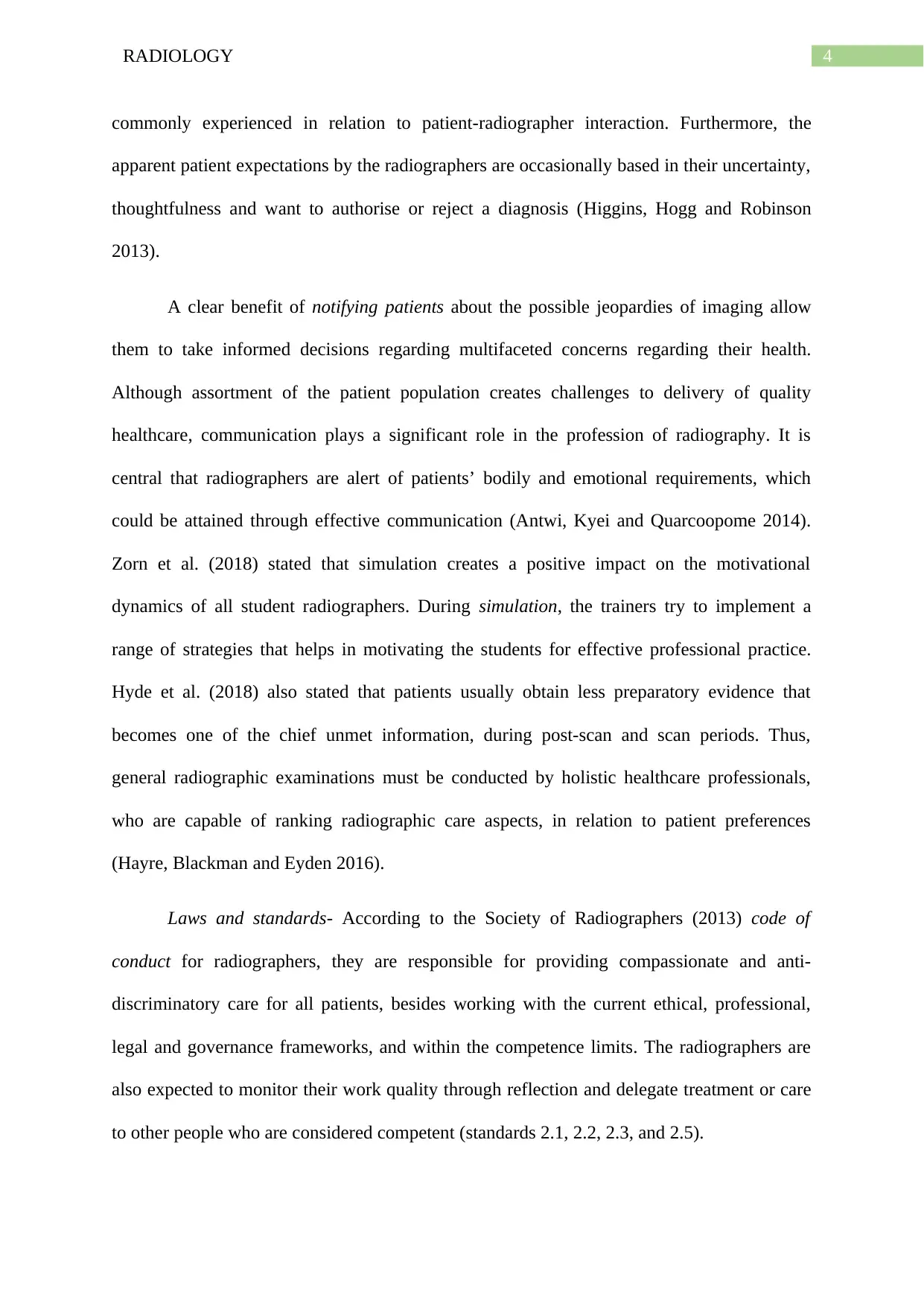
4RADIOLOGY
commonly experienced in relation to patient-radiographer interaction. Furthermore, the
apparent patient expectations by the radiographers are occasionally based in their uncertainty,
thoughtfulness and want to authorise or reject a diagnosis (Higgins, Hogg and Robinson
2013).
A clear benefit of notifying patients about the possible jeopardies of imaging allow
them to take informed decisions regarding multifaceted concerns regarding their health.
Although assortment of the patient population creates challenges to delivery of quality
healthcare, communication plays a significant role in the profession of radiography. It is
central that radiographers are alert of patients’ bodily and emotional requirements, which
could be attained through effective communication (Antwi, Kyei and Quarcoopome 2014).
Zorn et al. (2018) stated that simulation creates a positive impact on the motivational
dynamics of all student radiographers. During simulation, the trainers try to implement a
range of strategies that helps in motivating the students for effective professional practice.
Hyde et al. (2018) also stated that patients usually obtain less preparatory evidence that
becomes one of the chief unmet information, during post-scan and scan periods. Thus,
general radiographic examinations must be conducted by holistic healthcare professionals,
who are capable of ranking radiographic care aspects, in relation to patient preferences
(Hayre, Blackman and Eyden 2016).
Laws and standards- According to the Society of Radiographers (2013) code of
conduct for radiographers, they are responsible for providing compassionate and anti-
discriminatory care for all patients, besides working with the current ethical, professional,
legal and governance frameworks, and within the competence limits. The radiographers are
also expected to monitor their work quality through reflection and delegate treatment or care
to other people who are considered competent (standards 2.1, 2.2, 2.3, and 2.5).
commonly experienced in relation to patient-radiographer interaction. Furthermore, the
apparent patient expectations by the radiographers are occasionally based in their uncertainty,
thoughtfulness and want to authorise or reject a diagnosis (Higgins, Hogg and Robinson
2013).
A clear benefit of notifying patients about the possible jeopardies of imaging allow
them to take informed decisions regarding multifaceted concerns regarding their health.
Although assortment of the patient population creates challenges to delivery of quality
healthcare, communication plays a significant role in the profession of radiography. It is
central that radiographers are alert of patients’ bodily and emotional requirements, which
could be attained through effective communication (Antwi, Kyei and Quarcoopome 2014).
Zorn et al. (2018) stated that simulation creates a positive impact on the motivational
dynamics of all student radiographers. During simulation, the trainers try to implement a
range of strategies that helps in motivating the students for effective professional practice.
Hyde et al. (2018) also stated that patients usually obtain less preparatory evidence that
becomes one of the chief unmet information, during post-scan and scan periods. Thus,
general radiographic examinations must be conducted by holistic healthcare professionals,
who are capable of ranking radiographic care aspects, in relation to patient preferences
(Hayre, Blackman and Eyden 2016).
Laws and standards- According to the Society of Radiographers (2013) code of
conduct for radiographers, they are responsible for providing compassionate and anti-
discriminatory care for all patients, besides working with the current ethical, professional,
legal and governance frameworks, and within the competence limits. The radiographers are
also expected to monitor their work quality through reflection and delegate treatment or care
to other people who are considered competent (standards 2.1, 2.2, 2.3, and 2.5).
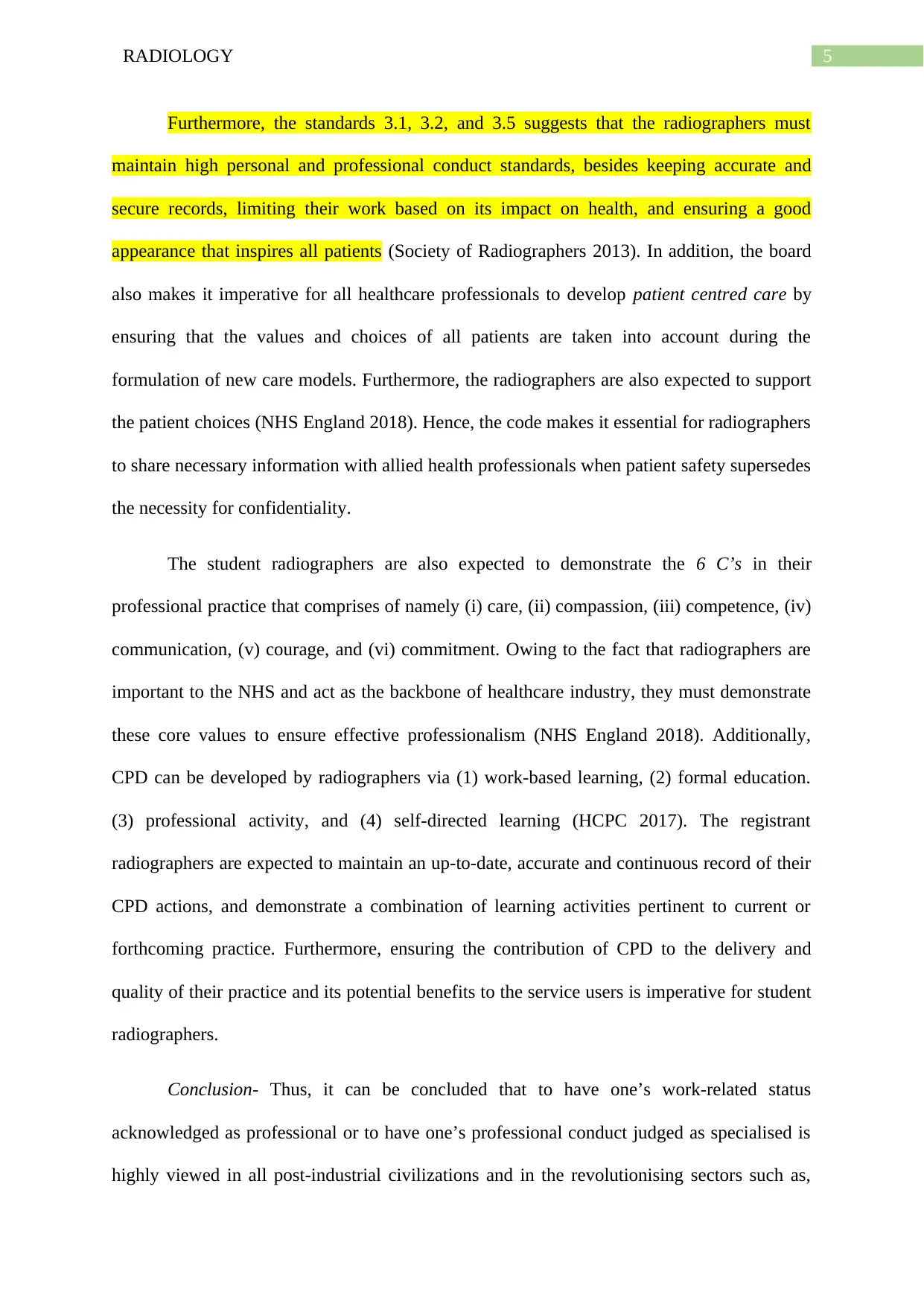
5RADIOLOGY
Furthermore, the standards 3.1, 3.2, and 3.5 suggests that the radiographers must
maintain high personal and professional conduct standards, besides keeping accurate and
secure records, limiting their work based on its impact on health, and ensuring a good
appearance that inspires all patients (Society of Radiographers 2013). In addition, the board
also makes it imperative for all healthcare professionals to develop patient centred care by
ensuring that the values and choices of all patients are taken into account during the
formulation of new care models. Furthermore, the radiographers are also expected to support
the patient choices (NHS England 2018). Hence, the code makes it essential for radiographers
to share necessary information with allied health professionals when patient safety supersedes
the necessity for confidentiality.
The student radiographers are also expected to demonstrate the 6 C’s in their
professional practice that comprises of namely (i) care, (ii) compassion, (iii) competence, (iv)
communication, (v) courage, and (vi) commitment. Owing to the fact that radiographers are
important to the NHS and act as the backbone of healthcare industry, they must demonstrate
these core values to ensure effective professionalism (NHS England 2018). Additionally,
CPD can be developed by radiographers via (1) work-based learning, (2) formal education.
(3) professional activity, and (4) self-directed learning (HCPC 2017). The registrant
radiographers are expected to maintain an up-to-date, accurate and continuous record of their
CPD actions, and demonstrate a combination of learning activities pertinent to current or
forthcoming practice. Furthermore, ensuring the contribution of CPD to the delivery and
quality of their practice and its potential benefits to the service users is imperative for student
radiographers.
Conclusion- Thus, it can be concluded that to have one’s work-related status
acknowledged as professional or to have one’s professional conduct judged as specialised is
highly viewed in all post-industrial civilizations and in the revolutionising sectors such as,
Furthermore, the standards 3.1, 3.2, and 3.5 suggests that the radiographers must
maintain high personal and professional conduct standards, besides keeping accurate and
secure records, limiting their work based on its impact on health, and ensuring a good
appearance that inspires all patients (Society of Radiographers 2013). In addition, the board
also makes it imperative for all healthcare professionals to develop patient centred care by
ensuring that the values and choices of all patients are taken into account during the
formulation of new care models. Furthermore, the radiographers are also expected to support
the patient choices (NHS England 2018). Hence, the code makes it essential for radiographers
to share necessary information with allied health professionals when patient safety supersedes
the necessity for confidentiality.
The student radiographers are also expected to demonstrate the 6 C’s in their
professional practice that comprises of namely (i) care, (ii) compassion, (iii) competence, (iv)
communication, (v) courage, and (vi) commitment. Owing to the fact that radiographers are
important to the NHS and act as the backbone of healthcare industry, they must demonstrate
these core values to ensure effective professionalism (NHS England 2018). Additionally,
CPD can be developed by radiographers via (1) work-based learning, (2) formal education.
(3) professional activity, and (4) self-directed learning (HCPC 2017). The registrant
radiographers are expected to maintain an up-to-date, accurate and continuous record of their
CPD actions, and demonstrate a combination of learning activities pertinent to current or
forthcoming practice. Furthermore, ensuring the contribution of CPD to the delivery and
quality of their practice and its potential benefits to the service users is imperative for student
radiographers.
Conclusion- Thus, it can be concluded that to have one’s work-related status
acknowledged as professional or to have one’s professional conduct judged as specialised is
highly viewed in all post-industrial civilizations and in the revolutionising sectors such as,
⊘ This is a preview!⊘
Do you want full access?
Subscribe today to unlock all pages.

Trusted by 1+ million students worldwide
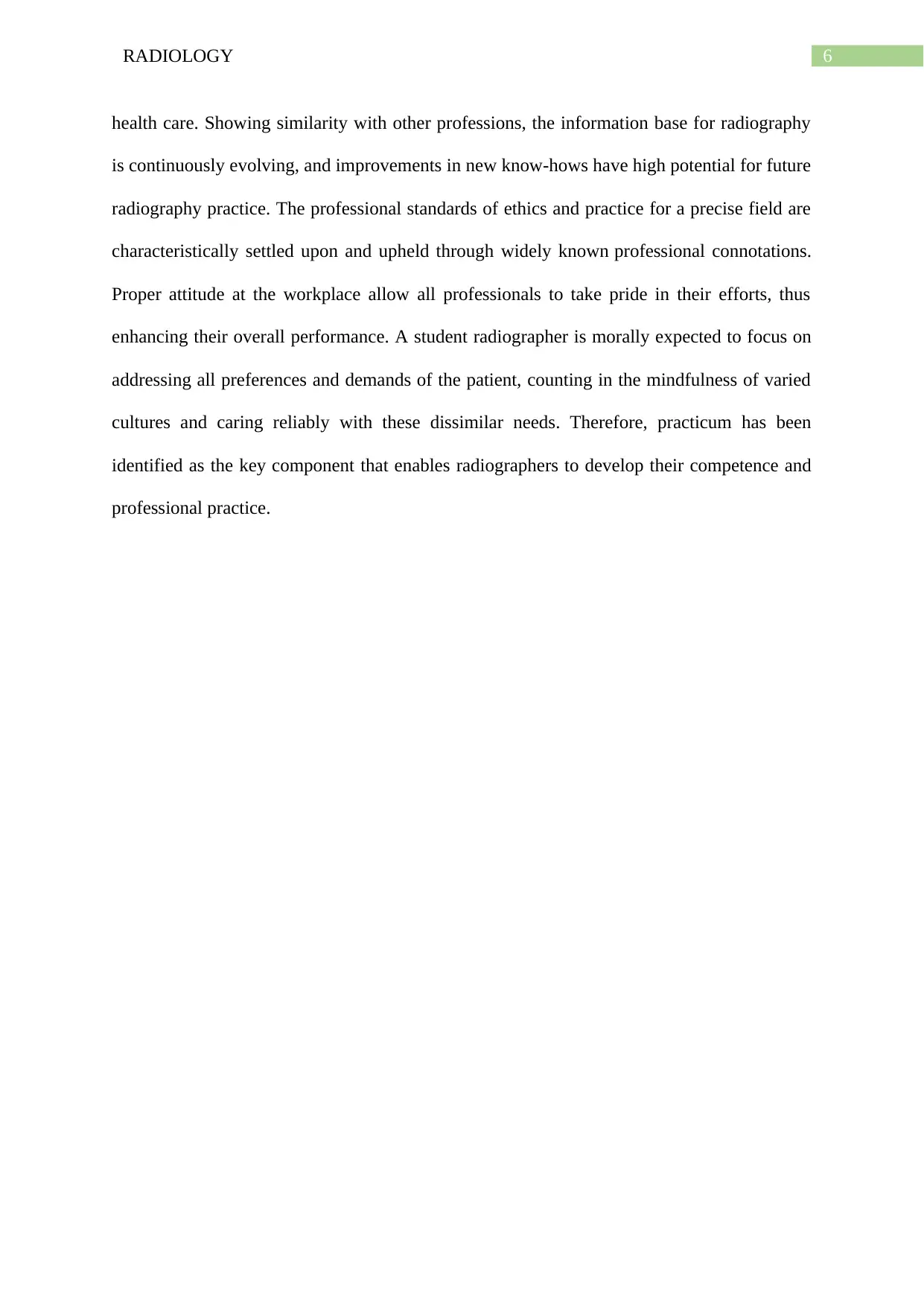
6RADIOLOGY
health care. Showing similarity with other professions, the information base for radiography
is continuously evolving, and improvements in new know-hows have high potential for future
radiography practice. The professional standards of ethics and practice for a precise field are
characteristically settled upon and upheld through widely known professional connotations.
Proper attitude at the workplace allow all professionals to take pride in their efforts, thus
enhancing their overall performance. A student radiographer is morally expected to focus on
addressing all preferences and demands of the patient, counting in the mindfulness of varied
cultures and caring reliably with these dissimilar needs. Therefore, practicum has been
identified as the key component that enables radiographers to develop their competence and
professional practice.
health care. Showing similarity with other professions, the information base for radiography
is continuously evolving, and improvements in new know-hows have high potential for future
radiography practice. The professional standards of ethics and practice for a precise field are
characteristically settled upon and upheld through widely known professional connotations.
Proper attitude at the workplace allow all professionals to take pride in their efforts, thus
enhancing their overall performance. A student radiographer is morally expected to focus on
addressing all preferences and demands of the patient, counting in the mindfulness of varied
cultures and caring reliably with these dissimilar needs. Therefore, practicum has been
identified as the key component that enables radiographers to develop their competence and
professional practice.
Paraphrase This Document
Need a fresh take? Get an instant paraphrase of this document with our AI Paraphraser

7RADIOLOGY
References
Antwi, W.K., Kyei, K.A. and Quarcoopome, L.N., 2014. Effectiveness of multicultural
communication between radiographers and patients and its impact on outcome of
examinations. World Journal of Medical Research, 3(4).
Busher, H. and Saran, R., 2013. Deskilling a profession: professionalism
deprofessionalisation and the new managerialism. In Managing teachers as professionals in
schools (pp. 35-52). Routledge.
Challen, V., Laanelaid, Z. and Kukkes, T., 2017. A qualitative study of perceptions of
professionalism amongst radiography students. Radiography, 23, pp.S23-S29.
Coventry, T.H., Maslin‐Prothero, S.E. and Smith, G., 2015. Organizational impact of nurse
supply and workload on nurses continuing professional development opportunities: an
integrative review. Journal of advanced nursing, 71(12), pp.2715-2727.
Evetts, J., 2013. Professionalism: Value and ideology. Current Sociology, 61(5-6), pp.778-
796.
Hayre, C.M., Blackman, S. and Eyden, A., 2016. Do general radiographic examinations
resemble a person-centred environment?. Radiography, 22(4), pp.e245-e251.
Health and Care Professions Council., 2017. Continuing professional development and your
registration. Available from
https://www.hcpc-uk.org/assets/documents/10001314CPD_and_your_registration.pdf Access
ed on 15 November 2018.
Higgins, R., Hogg, P. and Robinson, L., 2013. Towards a research informed teaching
experience within a diagnostic radiography curriculum: the level 4 (year 1) student holistic
experience. Radiography, 19(1), pp.62-66.
References
Antwi, W.K., Kyei, K.A. and Quarcoopome, L.N., 2014. Effectiveness of multicultural
communication between radiographers and patients and its impact on outcome of
examinations. World Journal of Medical Research, 3(4).
Busher, H. and Saran, R., 2013. Deskilling a profession: professionalism
deprofessionalisation and the new managerialism. In Managing teachers as professionals in
schools (pp. 35-52). Routledge.
Challen, V., Laanelaid, Z. and Kukkes, T., 2017. A qualitative study of perceptions of
professionalism amongst radiography students. Radiography, 23, pp.S23-S29.
Coventry, T.H., Maslin‐Prothero, S.E. and Smith, G., 2015. Organizational impact of nurse
supply and workload on nurses continuing professional development opportunities: an
integrative review. Journal of advanced nursing, 71(12), pp.2715-2727.
Evetts, J., 2013. Professionalism: Value and ideology. Current Sociology, 61(5-6), pp.778-
796.
Hayre, C.M., Blackman, S. and Eyden, A., 2016. Do general radiographic examinations
resemble a person-centred environment?. Radiography, 22(4), pp.e245-e251.
Health and Care Professions Council., 2017. Continuing professional development and your
registration. Available from
https://www.hcpc-uk.org/assets/documents/10001314CPD_and_your_registration.pdf Access
ed on 15 November 2018.
Higgins, R., Hogg, P. and Robinson, L., 2013. Towards a research informed teaching
experience within a diagnostic radiography curriculum: the level 4 (year 1) student holistic
experience. Radiography, 19(1), pp.62-66.
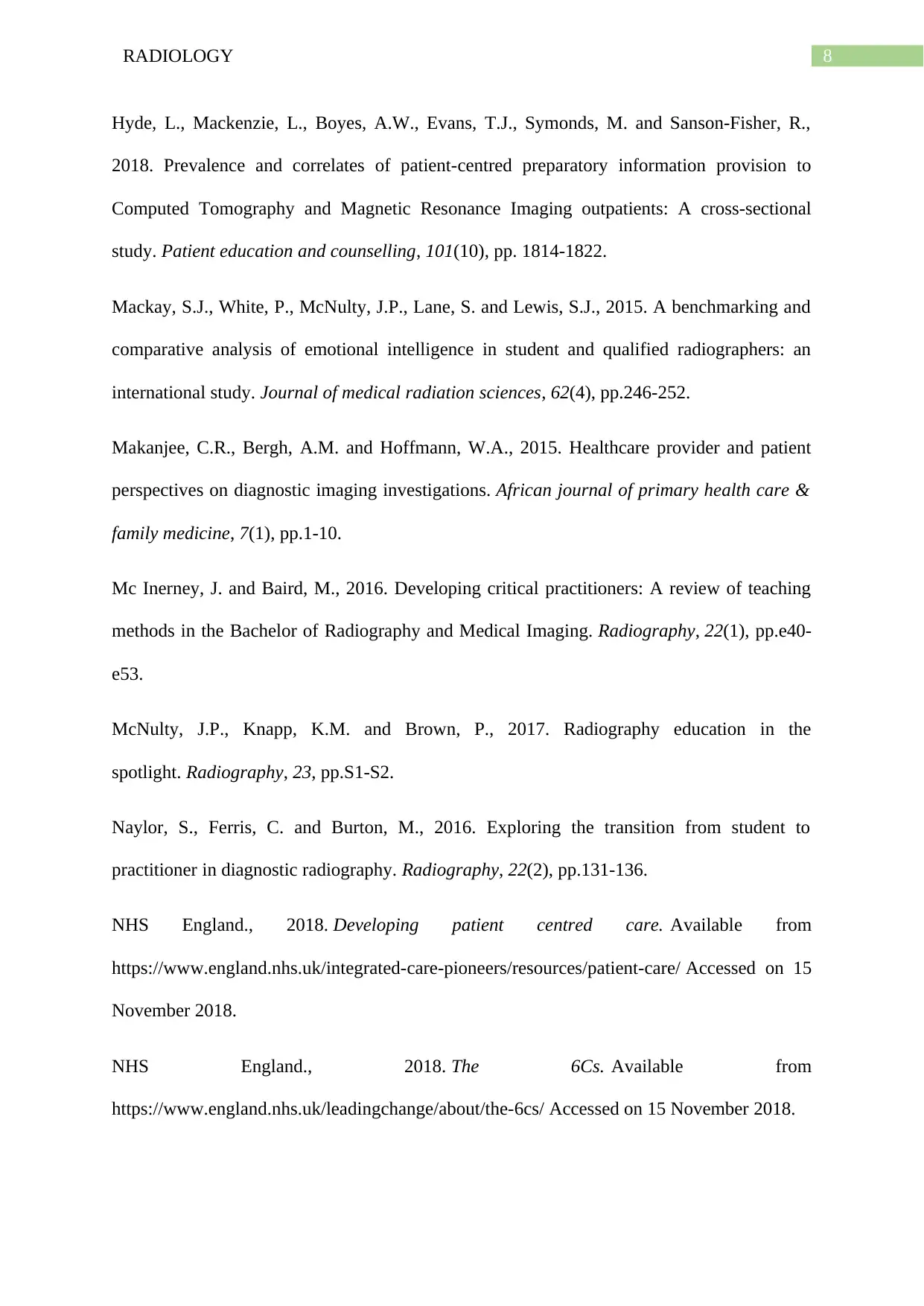
8RADIOLOGY
Hyde, L., Mackenzie, L., Boyes, A.W., Evans, T.J., Symonds, M. and Sanson-Fisher, R.,
2018. Prevalence and correlates of patient-centred preparatory information provision to
Computed Tomography and Magnetic Resonance Imaging outpatients: A cross-sectional
study. Patient education and counselling, 101(10), pp. 1814-1822.
Mackay, S.J., White, P., McNulty, J.P., Lane, S. and Lewis, S.J., 2015. A benchmarking and
comparative analysis of emotional intelligence in student and qualified radiographers: an
international study. Journal of medical radiation sciences, 62(4), pp.246-252.
Makanjee, C.R., Bergh, A.M. and Hoffmann, W.A., 2015. Healthcare provider and patient
perspectives on diagnostic imaging investigations. African journal of primary health care &
family medicine, 7(1), pp.1-10.
Mc Inerney, J. and Baird, M., 2016. Developing critical practitioners: A review of teaching
methods in the Bachelor of Radiography and Medical Imaging. Radiography, 22(1), pp.e40-
e53.
McNulty, J.P., Knapp, K.M. and Brown, P., 2017. Radiography education in the
spotlight. Radiography, 23, pp.S1-S2.
Naylor, S., Ferris, C. and Burton, M., 2016. Exploring the transition from student to
practitioner in diagnostic radiography. Radiography, 22(2), pp.131-136.
NHS England., 2018. Developing patient centred care. Available from
https://www.england.nhs.uk/integrated-care-pioneers/resources/patient-care/ Accessed on 15
November 2018.
NHS England., 2018. The 6Cs. Available from
https://www.england.nhs.uk/leadingchange/about/the-6cs/ Accessed on 15 November 2018.
Hyde, L., Mackenzie, L., Boyes, A.W., Evans, T.J., Symonds, M. and Sanson-Fisher, R.,
2018. Prevalence and correlates of patient-centred preparatory information provision to
Computed Tomography and Magnetic Resonance Imaging outpatients: A cross-sectional
study. Patient education and counselling, 101(10), pp. 1814-1822.
Mackay, S.J., White, P., McNulty, J.P., Lane, S. and Lewis, S.J., 2015. A benchmarking and
comparative analysis of emotional intelligence in student and qualified radiographers: an
international study. Journal of medical radiation sciences, 62(4), pp.246-252.
Makanjee, C.R., Bergh, A.M. and Hoffmann, W.A., 2015. Healthcare provider and patient
perspectives on diagnostic imaging investigations. African journal of primary health care &
family medicine, 7(1), pp.1-10.
Mc Inerney, J. and Baird, M., 2016. Developing critical practitioners: A review of teaching
methods in the Bachelor of Radiography and Medical Imaging. Radiography, 22(1), pp.e40-
e53.
McNulty, J.P., Knapp, K.M. and Brown, P., 2017. Radiography education in the
spotlight. Radiography, 23, pp.S1-S2.
Naylor, S., Ferris, C. and Burton, M., 2016. Exploring the transition from student to
practitioner in diagnostic radiography. Radiography, 22(2), pp.131-136.
NHS England., 2018. Developing patient centred care. Available from
https://www.england.nhs.uk/integrated-care-pioneers/resources/patient-care/ Accessed on 15
November 2018.
NHS England., 2018. The 6Cs. Available from
https://www.england.nhs.uk/leadingchange/about/the-6cs/ Accessed on 15 November 2018.
⊘ This is a preview!⊘
Do you want full access?
Subscribe today to unlock all pages.

Trusted by 1+ million students worldwide

9RADIOLOGY
Sloane, C. and Miller, P.K., 2017. Informing radiography curriculum development: The
views of UK radiology service managers concerning the ‘fitness for purpose’of recent
diagnostic radiography graduates. Radiography, 23, pp.S16-S22.
Society of Radiographers., 2013. Code of Professional Conduct. Available from
https://www.sor.org/learning/document-library/code-professional-conduct Accessed on 15
November 2018.
Stevens, B.J. and White, N., 2018. Newly qualified radiographers' perceptions of their
abnormality detection abilities and the associated training they received at undergraduate
level. Radiography.
Waisbord, S., 2013. Reinventing professionalism: Journalism and news in global perspective.
John Wiley & Sons.
Zorn, C., Dillenseger, J.P., Bauer, E., Moerschel, E., Bachmann, B., Buissink, C. and
Jamault, B., 2018. Motivation of student radiographers in learning situations based on role-
play simulation: A multicentric approach involving trainers and students. Radiography.
Retrieved from https://www.sciencedirect.com/science/article/pii/S1078817418301986
Sloane, C. and Miller, P.K., 2017. Informing radiography curriculum development: The
views of UK radiology service managers concerning the ‘fitness for purpose’of recent
diagnostic radiography graduates. Radiography, 23, pp.S16-S22.
Society of Radiographers., 2013. Code of Professional Conduct. Available from
https://www.sor.org/learning/document-library/code-professional-conduct Accessed on 15
November 2018.
Stevens, B.J. and White, N., 2018. Newly qualified radiographers' perceptions of their
abnormality detection abilities and the associated training they received at undergraduate
level. Radiography.
Waisbord, S., 2013. Reinventing professionalism: Journalism and news in global perspective.
John Wiley & Sons.
Zorn, C., Dillenseger, J.P., Bauer, E., Moerschel, E., Bachmann, B., Buissink, C. and
Jamault, B., 2018. Motivation of student radiographers in learning situations based on role-
play simulation: A multicentric approach involving trainers and students. Radiography.
Retrieved from https://www.sciencedirect.com/science/article/pii/S1078817418301986
1 out of 10
Related Documents
Your All-in-One AI-Powered Toolkit for Academic Success.
+13062052269
info@desklib.com
Available 24*7 on WhatsApp / Email
![[object Object]](/_next/static/media/star-bottom.7253800d.svg)
Unlock your academic potential
Copyright © 2020–2025 A2Z Services. All Rights Reserved. Developed and managed by ZUCOL.



